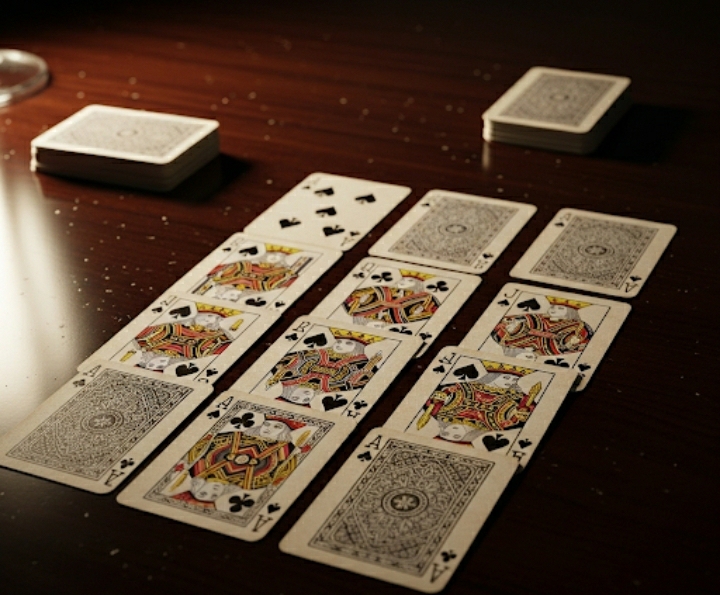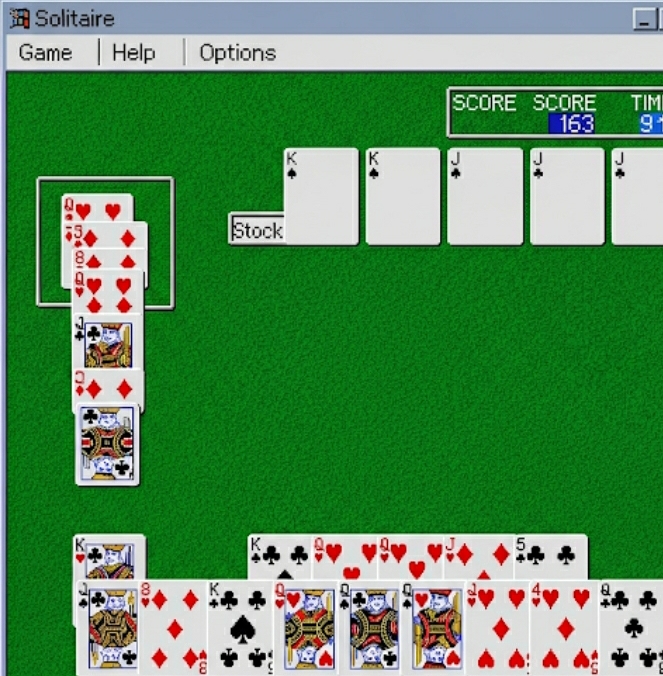Ever found yourself clicking through endless games of Spider Solitaire during a boring afternoon? You’re not alone—and you’re participating in a tradition that stretches back centuries. The history of solitaire reveals a fascinating journey from aristocratic parlors to computer screens, transforming from a nobleman’s pastime into one of the world’s most played digital games.
What started as “Patience” in 18th-century Europe has become so embedded in modern culture that Microsoft’s version alone has been played by over a billion people. But how did this solitary card game capture hearts across generations and continents? Let’s shuffle through the remarkable story of solitaire’s evolution from traditional card tables to our digital devices.
The Royal Origins: Solitaire in European Courts
The French Connection: Where It All Began
The earliest documented history of solitaire traces back to 1783 in a German gaming anthology, though many historians believe the game originated in France during the late 1600s. French nobles, particularly during long winters at Versailles, needed entertainment that didn’t require multiple players or elaborate setups.
Napoleon Bonaparte himself was reportedly an avid solitaire player, often seen arranging cards during his exile on St. Helena. This royal endorsement helped spread the game throughout European aristocracy, where it became known as “Patience”—a fitting name for a game that required both strategy and, well, patience.

Spreading Across the Atlantic: Solitaire Reaches America
By the mid-1800s, European immigrants brought solitaire variations to America. The game’s appeal transcended social classes because it required only a standard deck of cards and could be played anywhere. During the California Gold Rush, miners spent countless hours playing solitaire in remote camps, helping cement its place in American culture.
The term “solitaire” itself comes from the French word meaning “alone” or “single,” perfectly capturing the game’s solitary nature that appealed to a growing nation of independent spirits.
The Golden Age: Traditional Solitaire Variations
Classic Games That Defined Generations
The late 19th and early 20th centuries saw an explosion of solitaire variations. Each region developed its own preferred styles:
- Klondike Solitaire: The most recognizable version, featuring seven tableau columns
- Spider Solitaire: A more challenging variant using two decks
- FreeCell: Known for its high win rate and strategic depth
- Pyramid Solitaire: A unique triangular layout that tested different skills
These weren’t just games—they were social phenomena. Ladies’ magazines regularly featured new solitaire variations, and card game books dedicated entire sections to patience games. One 1920s guidebook listed over 150 different solitaire variations!
The Psychology Behind the Appeal
What made solitaire so addictive? Psychologists note that the game provides the perfect balance of skill and luck. Unlike chess, which can feel overwhelming, or pure chance games that offer no control, solitaire gives players just enough agency to feel responsible for their success while maintaining the unpredictability that keeps things interesting.
Dr. Jane McGonigal, a game designer and researcher, explains that solitaire activates the brain’s reward system through “intermittent reinforcement”—the same psychological principle that makes gambling addictive, but in a harmless, meditative context.
The Digital Revolution: Microsoft Changes Everything
Windows 3.0: The Game-Changer
The history of solitaire took a dramatic turn in 1990 when Microsoft included Solitaire with Windows 3.0. What began as a simple tutorial to teach users drag-and-drop mouse techniques became the most-played computer game in history.
Wes Cherry, the Microsoft intern who coded the original Windows Solitaire, never received royalties for his creation. His simple program, designed in his spare time, inadvertently shaped how millions of people interacted with their computers.

The Numbers Are Staggering
Consider these mind-blowing statistics about digital solitaire:
| Era | Platform | Players | Notable Achievement |
|---|---|---|---|
| 1990s | Windows 3.0-98 | 50+ million | First pre-installed PC game |
| 2000s | Windows XP | 400+ million | Peak office productivity killer |
| 2010s | Mobile apps | 100+ million annually | Top casual game category |
| 2020s | All platforms | 1+ billion lifetime | Most-played game in history |
From Desktop to Mobile: The Second Wave
The smartphone revolution brought solitaire full circle. Suddenly, the game that once required a physical deck of cards could be played anywhere, anytime. Mobile versions added features our ancestors never imagined: hints, unlimited undos, and achievement systems that gamified the traditional experience.
Apps like Microsoft Solitaire Collection and Solitaire Grand Harvest have generated hundreds of millions in revenue, proving that this centuries-old concept still has serious commercial appeal.
Modern Variations: Solitaire in the Digital Age
Innovation Within Tradition
Today’s digital solitaire games push boundaries while respecting tradition. Features like:
- Daily challenges that create community around a solitary game
- Multiplayer competitions that seem to contradict solitaire’s nature
- Story modes that add narrative elements to card games
- Augmented reality versions that blend physical and digital experiences
These innovations demonstrate how game designers continue finding fresh approaches to this timeless format.
The Casual Gaming Revolution
Solitaire’s influence extends far beyond card games. Its design principles—easy to learn, difficult to master, satisfying incremental progress—became the template for modern casual gaming. Games like Candy Crush Saga and Angry Birds owe a debt to solitaire’s psychological hooks.
Why Solitaire Endures: The Timeless Appeal
More Than Just Entertainment
The history of solitaire reveals why this game has survived technological revolutions that killed countless other entertainment forms. Solitaire offers:
Meditation in Motion: The repetitive, rhythmic nature provides a form of active meditation that busy minds crave.
Achievable Goals: Unlike life’s complex challenges, solitaire offers clear objectives with definitive endpoints.
Perfect Solitude: In our hyper-connected world, solitaire provides guilt-free alone time that feels productive rather than isolating.
Nostalgic Comfort: For many, the familiar sound of cards cascading down the screen triggers positive memories and stress relief.
The Future of Solitaire: What’s Next?
As we look ahead, solitaire continues evolving. Virtual reality versions let players manipulate cards in three-dimensional space, while AI opponents provide increasingly sophisticated challenges. Some developers experiment with blockchain integration, creating collectible digital cards that blur lines between gaming and investing.
Yet for all its technological advancement, solitaire’s core appeal remains unchanged: it’s a perfect game for imperfect moments, offering structure when life feels chaotic and solitude when the world feels too crowded.
Conclusion
The history of solitaire is really the history of human adaptation and ingenuity. From French courts to smartphone screens, this simple card game has provided generations with entertainment, meditation, and gentle challenge. Its evolution mirrors our own technological journey while proving that some human needs—for solitude, achievement, and peaceful focus—remain constant across centuries.
Whether you’re playing with physical cards or tapping a screen, you’re participating in a tradition that connects you to Napoleon, Gold Rush miners, and millions of modern players worldwide. That’s the true magic of solitaire: in a game designed for one, we’re never really alone.
What’s your favorite solitaire memory? Share your story in the comments below, or tell us which version you grew up playing!
Frequently Asked Questions
What is the oldest version of solitaire?
The oldest documented solitaire game appears in a 1783 German book called “Das neue Königliche L’Hombre-Spiel,” though historians believe similar games existed earlier in France. The game “Patience” is considered the direct ancestor of modern Klondike Solitaire.
Why is solitaire called “Patience” in some countries?
The name “Patience” comes from the French word for the same quality, reflecting the game’s meditative nature and the patience required to work through challenging layouts. British and European versions still commonly use this term, while Americans adopted “solitaire” from the French word meaning “alone.”
How many different types of solitaire games exist?
Card game enthusiasts have documented over 500 distinct solitaire variations, though only about 20-30 are widely known. Popular variants include Klondike, Spider, FreeCell, Pyramid, TriPeaks, and Golf Solitaire, each offering unique challenges and strategies.
Is Windows Solitaire really the most-played computer game ever?
Yes, Microsoft Solitaire holds this distinction with over 1 billion players since 1990. Its inclusion with Windows installations made it accessible to virtually every PC user for decades, far exceeding the reach of any commercial video game.
Can you actually win every game of solitaire?
This depends on the variant. FreeCell has a nearly 100% win rate with perfect play, while standard Klondike Solitaire is winnable approximately 79% of the time. Spider Solitaire with one suit is nearly always winnable, but four-suit Spider has a much lower win rate.
What psychological benefits does playing solitaire provide?
Research suggests solitaire can reduce stress, improve focus, and provide a form of active meditation. The game’s combination of strategy and chance activates reward pathways in the brain while requiring minimal cognitive load, making it an effective mental break during stressful periods.
Sources:
- Parlett, David. “The Penguin Encyclopedia of Card Games.” Penguin Books, 2008.
- McGonigal, Jane. “Reality Is Broken: Why Games Make Us Better and How They Can Change the World.” Penguin Press, 2011.
- Microsoft Corporation. “The History of Microsoft Solitaire.” Microsoft Games Archive, accessed 2024.